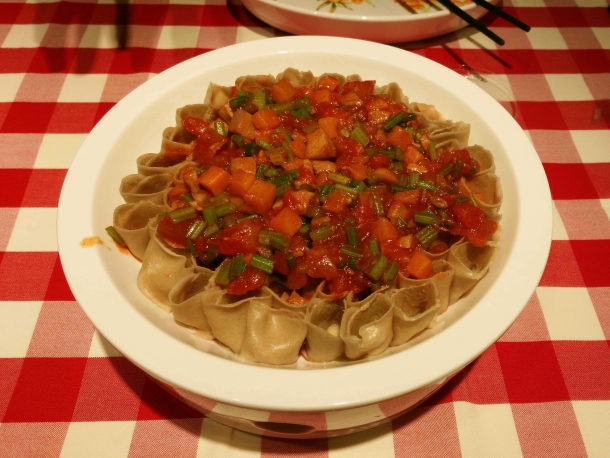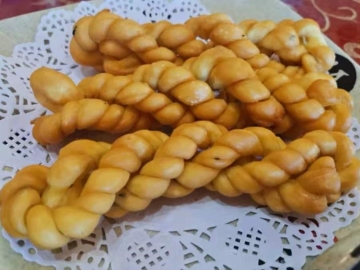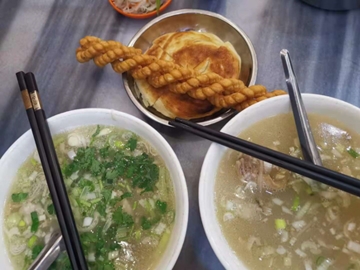Wheaten dishes remind me of my hometown but also my mother and those treasured memories
Fourth-year student at the School of Political Science and Economics
Cai Yifan
 Speaking of China, it’s natural to think of cities like Beijing, Shanghai, etc. Shanxi Province, my hometown, as a whole is very limitedly known, which I believe is quite a pity since there are a lot of stories to tell and among which I’d like to elaborate about its fantastic culture of wheaten food.
Speaking of China, it’s natural to think of cities like Beijing, Shanghai, etc. Shanxi Province, my hometown, as a whole is very limitedly known, which I believe is quite a pity since there are a lot of stories to tell and among which I’d like to elaborate about its fantastic culture of wheaten food.
As the saying goes “China stands out of the world in terms of wheaten food, while Shanxi stands out of China in terms of wheaten food.” People in Shanxi Province has around 2,000-year history of making wheaten food and there are currently around three hundreds types of wheaten food within the whole province.
It is where Shanxi is located makes Shanxi the kingdom of wheaten food. Shanxi is located in plateau inland where enable those corns that can stand drought to grow up. This natural condition has longingly molded various wheaten cuisines, and largely we can categorize them based on how we make them – boil, steam and fry.
For boiled noodles, the most known one is “Daoxiao Mian(刀削麺)”, which is regarded as the brand of Shanxi over China. It’s made through a very delicate method : chefs need to be trained specifically to use blades to slice the paste into strips of noodles. Therefore, the noodles are with enough chewiness but without much thickness.

Daoxiao Mian(刀削麺)

It is usually eaten with black vinegar or tomato-based sauce.
Boiled noodles are quite common in other parts of world as well, however, steamed noodles are relatively rarely shown up globally. Among which, the most interesting one I believed is “Youmian Kaolaolao(莜麺栲栳栳)”, a fence-shaped steamed oats food. “Youmian(莜麺)” stands for “oat” in Chinese, while “kaolaolao(栲栳栳)” refers to the fence-like shape. This dish is famous for its texture, because it’s made of oat instead of wheat which makes it less sweet; and its health value, oat is known to possess the value of reducing the blood pressure and dieting. Youmian Kaolaolao tastes relatively bland and people tend to have them with tomato sauce or vinegar sauce, in which vinegar is another known special in Shanxi Province because it helps to promote digestion especially for People in Shanxi Province since their lives are filled with all kinds of wheaten food.
A video I posted on SNS. “麻麻做莜面!” means “My mother is making Youmian!” (The official pronunciation of “mother” is “妈妈(māma) ”, but sometimes “麻麻(mámá)” is used because it has a similar pronunciation.
Besides the two types above, the last type is fried wheaten food, in which “Mahua(麻花)” is regarded as a typical representative. Paste will be cut into strips and strips will be twisted artfully and fried to become a “mahua”. The way it’s made not only makes it crisper than other types of wheaten food but also makes it specially fantastic partner of different porridge for breakfast.
Mahua(麻花) is great with porridge.
There are of course a lot of wheaten dishes that are to be covered and they makes my childhood and hasn’t become a treasured memory until I went to any other parts of the world and realized it’s so hard to find a place with fantastic and artfully made wheaten cuisines. Just like the saying goes “every Cantonese wife is supposed to know how to make good soup”, my mother is a brilliant wheaten food chef and it’s always a pleasure to watch the cooking process by her side. I guess it is her who makes wheaten dishes more special to me as a whole — they not only remind me of my hometown but also my mother and those treasured memories.
Left : At the park(森林公園) in Taiyuan City, Shanxi Province, my hometown. This park is large, beautiful and clean. I often visit there on weekends.
Right : With my mother (right).
◎What Shanxi is like◎
Shanxi Province is located in northern China, in the middle reaches of the Yellow River, east of the Loess Plateau and west of Taixing Mountain, hence the name “Shanxi. It was part of the Jin Dynasty during the Spring and Autumn Warring States Period, so its other name is “Jin”. The provincial capital is Taiyuan City. It takes about 1 hour and 20 minutes by air from Beijing, the capital of China, to Taiyuan. The area is about 156,300㎢ and the population is about 37 million (2018). The time difference from Japan is minus one hour, and it is dry throughout the year, with cold winters and relatively cool summers. Besides wheaten food, black vinegar is also famous.











